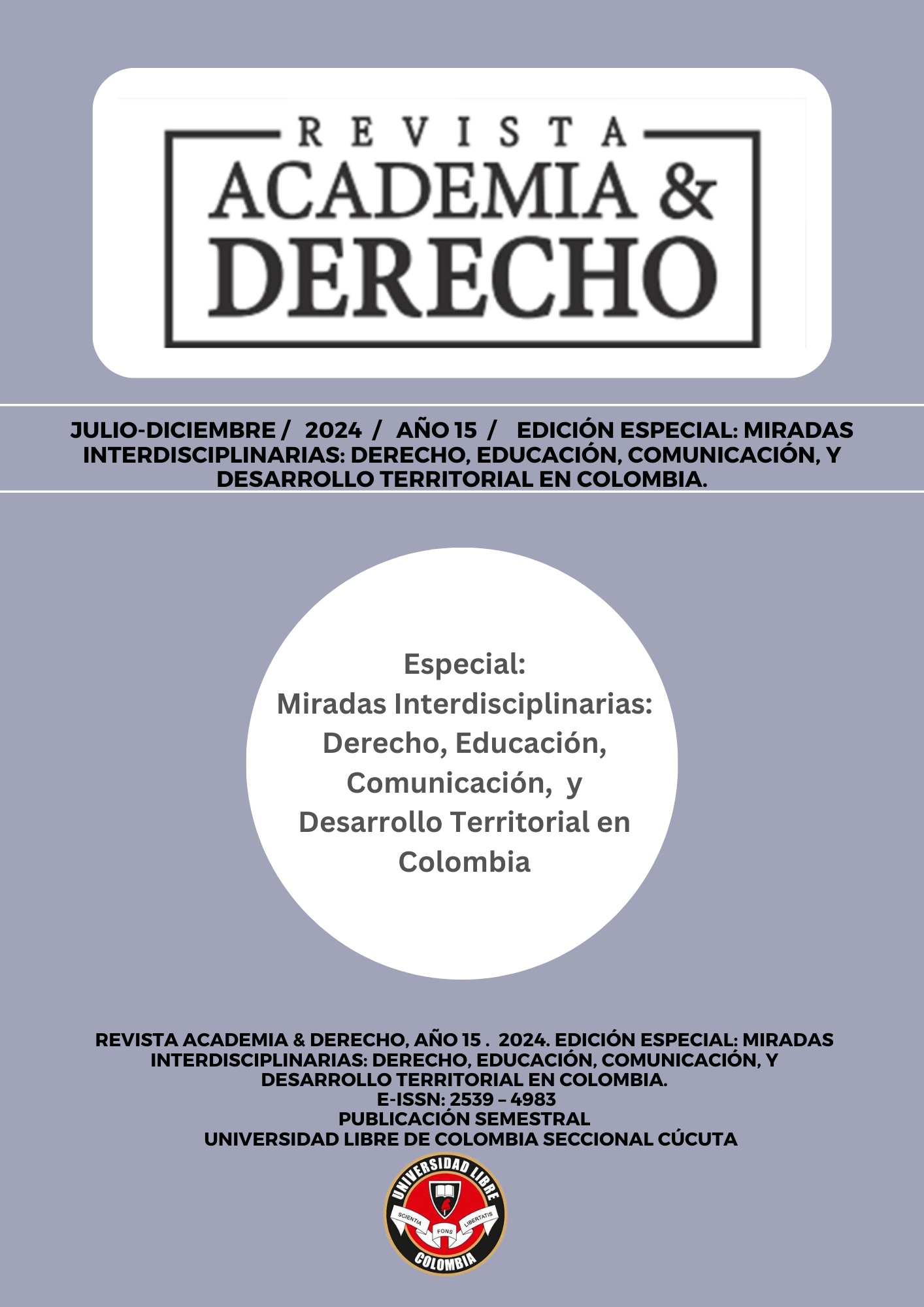Intersectional approach in REDD+ projects in the indigenous territories in Colombia
DOI:
https://doi.org/10.18041/2215-8944/academia..12671Keywords:
Constitutional Protection, Indigenous Rights, Intersectionality, REDD+Abstract
Indigenous communities in Colombia have historically suffered the violation of their fundamental rights, including the denial of their ancestral territorial possession, their constitutional protection status, and their right to free and informed consultation. In addition, the State's commitments under the United Nations Framework Convention on Climate Change have been breached. This research aims to examine how the intersectional approach can be a tool to ensure the fundamental rights of native peoples in relation to the implementation of Reducing Emissions from Deforestation and Forest Degradation (REDD+) projects, especially in the context of international and domestic regulations. To develop the main research, the hermeneutical approach was used, through the exegetic and systematic method, for which a documentary review was carried out, which allowed to establish through the following writing plan: i) the international and domestic framework for the protection of indigenous communities ii) REDD+ projects; iii) the standards for the protection of indigenous rights in REDD+ projects and, iv) the applicability of the intersectional approach to guarantee these rights. As a result, a deficit in the protection of collective rights and unconstitutional practices were evident in the implementation of REDD+ projects, in light of the massive violation of rights as subjects of special protection. The research underlines the need to adhere to the international regulatory framework to protect these rights and highlights the lack of effective implementation of the intersectional approach, which prevents the adequate protection and respect of indigenous rights.
References
Álvarez Undurraga, G. (2002). Metodología de la investigación jurídica: hacia una nueva perspectiva (1 ed.). Santiago de Chile. Universidad Central de Chile. Obtenido de https://bibliotecavirtualceug.files.wordpress.com/2017/05/doc.pdf
Anchondo Paredes, V. E. Métodos de Interpretación Jurídica. Quid iuris, Chihuahua, 16, 33- 58. https://biblat.unam.mx/hevila/Quidiuris/2012/vol16/3.pdf
Asamblea general de Naciones Unidas (2014). La Primera Conferencia Mundial sobre los Pueblos Indígenas se ha celebrado en Nueva York el 22 y 23 de septiembre de 2014. Obtenido de https://documents.un.org/doc/undoc/gen/n14/468/32/pdf/n1446832.pdf
Asamblea Nacional Constituyente. (Julio de 1991). Función Pública. Obtenido de Constitución Política de 1991: https://www.funcionpublica.gov.co/eva/gestornormativo/norma.php?i=4125
Diaz Montaña, J. W. (2021). Repositorio Uniandes. Obtenido de REDD+: una apuesta limitada para el reconocimiento de los derechos indígenas a la autonomía y al territorio. El caso de los indígenas Piaroa del resguardo Matavén: https://repositorio.uniandes.edu.co/server/api/core/bitstreams/9636ea56-809a-45e2-91fa-b2f66ab168e8/content
Fundación Gaia Amazonas. (2023). Gaia Amazonas. Obtenido de PROBLEMAS Y OPORTUNIDADES DE REDD+Una mirada desde los territorios indígenas de la Amazonía: https://gaiaamazonas.org/wp-content/uploads/2024/02/REDD_policy_paper_VF_web.pdf
Instituto Nacional de los Pueblos Indigenas. (2016). México. Obtenido de Día Internacional de la Madre Tierra. La visión indígena.: https://www.gob.mx/inpi/articulos/dia-internacional-de-la-madre-tierra-la-vision-indigena
Oficina Internacional del trabajo (1989). Convenio Núm. 169 de la OIT sobre Pueblos Indígenas y Tribales. Organización de las Naciones Unidas. Obtenido de https://normlex.ilo.org/dyn/normlex/es/f?p=NORMLEXPUB:12100:0::NO::P12100_ILO_CODE:C169
Organización de las Naciones Unidas (1948). Declaración Universal de Derechos Humanos. Obtenido de https://www.un.org/es/about-us/universal-declaration-of-human-rights
Organización de las Naciones Unidas (2007). La Declaración de las Naciones Unidas sobre los derechos de los pueblos indígenas. Obtenido de https://www.un.org/esa/socdev/unpfii/documents/DRIPS_es.pdf
Organización de las Naciones Unidas (1992). La Convención Marco de Naciones Unidas sobre el Cambio Climático (CMNUCC). Obtenido de https://www.miteco.gob.es/es/cambio-climatico/temas/el-proceso-internacional-de-lucha-contra-el-cambio-climatico/naciones-unidas.html#:~:text=en%20la%20materia.-,La%20Convenci%C3%B3n%20Marco%20de%20Naciones%20Unidas%20sobre%20el%20Cambio%20Clim%C3%A1tico,de%20Lucha%20contra%20la%20Desertificaci%C3%B3n).
Reátegui mendoza, a. (2023). El derecho a la consulta previa de los pueblos originarios e indígenas en el perú: ¿una realidad utópica?. Sapientia & iustitia, (8), 123–139. Obtenido de Https://doi.org/10.35626/sapientia.8.4.95
Tapia, A., Herrera-Feijoo, R. J., Ushigua, M., Garcia-Cox, W., Paguay C., G. P., & Correa-Salgado, M. de L. (2023). REDD+ en comunidades indígenas: Oportunidades y desafíos en la Nacionalidad Sápara del Ecuador. Green World Journal, 6(2), 65. https://doi.org/10.53313/gwj62065
Asamblea Nacional Constituyente (1991, 20 de julio). Constitución Política de Colombia. Gaceta Constitucional No. 116, de 20 de julio de 1991. Obtenido de http://www.secretariasenado.gov.co/senado/basedoc/constitucion_politica_1991.html
Downloads
Published
Versions
- 2025-06-25 (3)
- 2025-04-07 (2)
- 2025-03-28 (1)
Issue
Section
License
Copyright (c) 2025 Academia & Derecho

This work is licensed under a Creative Commons Attribution-NonCommercial-ShareAlike 4.0 International License.


